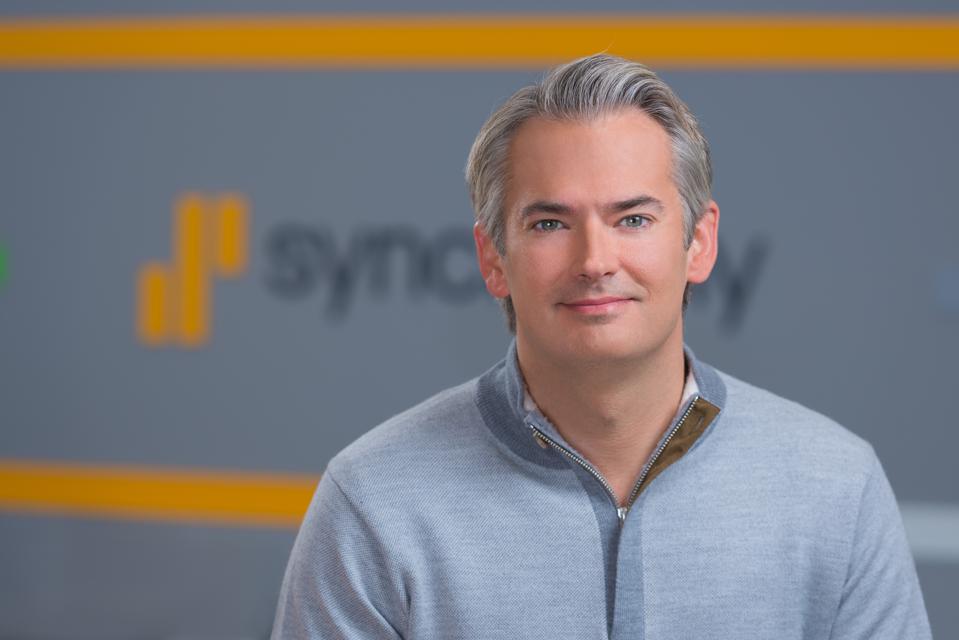
Brian Doubles became CEO at consumer financial services company Synchrony earlier this year. He’s since impacted areas from strategy to organization design and operations. We spoke recently about the shift, Synchrony’s new strategy and how working remotely has helped his team stay aligned.
Karen Walker: Brian, you’ve only been in your role for a few months. What was that transition like for you?
Brian Doubles: I was appointed president of the company in 2019, and we announced in April of this year that I would also take on the CEO role.
The biggest challenge? Not being able to engage with the employees face to face. It’s been a very different dynamic than I had pictured. I thought a lot about taking this role over the years, and I never thought I would do my first town hall as CEO on a Zoom call. But it has been fantastic. I love this company, and this is the company that I wanted to run as CEO.
Walker: What are the main tenets of your strategy for Synchrony?
Doubles: We’re doing so much to transform and diversify the business right now. We’re not just a credit card or private label company. We’re a technology company. We say we’re an 80-year-old startup, given our GE heritage.
After I took over as CEO, we announced a significant reorganization.
We moved to five sales platforms that are aligned by industry. Digital, with partners like PayPal, Venmo and Amazon, home and auto, health and wellness, diversified and value (e.g., Sam’s Club and TJX) and lifestyle. That allowed us to anticipate the needs of our partners better. We also created a product organization. Leveraging our comprehensive product set in the industry and making it easy to integrate those products are big parts of the strategy.
Walker: You have three overarching initiatives: innovate, replicate and scale. How is your new partnership with Clover supporting those?
Doubles: We used to integrate in only one way: directly with one partner, one-to-one. What is most exciting about the Clover announcement is that it allows us to build once and scale it across all the Clover merchants.
Our app, which is accessible in the Clover terminal, can be downloaded by our partners, and they instantly have access to the Synchrony financing products – such as our cards, buy now-pay later, et cetera.
This is a great way to scale our products across thousands of merchants by developing one technology solution.
Walker: Let me share a quote from Carol Juel (Synchrony’s executive vice-president and chief technology and operations officer) about the spinoff from GE. She said, “We were creating a company. We rebuilt the technology foundation, which was an unbelievable experience for a Fortune 200 company. I still remember the meeting where I went in with the ask. Just 20 minutes into the meeting, the CFO said, ‘Make it happen.’”
Those are the moments from a career that you remember. I’m assuming you were the CFO.
Doubles: I remember that day very well. We had not necessarily made all the investments that we needed to when we were part of GE on the technology front.
I could tell that she was a little uncomfortable because it was a big budget that she was requesting. But we knew what we wanted the company to look like five or ten years from that point, and we knew it would take a big investment. So, I prepared myself for it. I also have a tremendous amount of confidence in Carol, and it took a lot of courage for Carol to come in and say, “Hey, look, this is what I need.” I wanted to make sure that she knew that she had my unwavering support to build what we needed to build. She, and the team, absolutely delivered.
It was one of the best decisions we made before the IPO.
Walker: How do you keep the rest of your team focused and aligned, growing as fast as you are?
Doubles: I think working virtually has helped us move faster. Pre-pandemic, our leadership team was flying all over for in-person meetings with our partners and to meet our teams.
It was hard to pin down the leadership team to make some critical decisions. You could assemble half of us, or maybe 70% of us, but it was hard to schedule all of us. One of the things that we saw as we started working virtually was that we were so much more accessible to each other and to our groups.
Decisions were being made fast. We stood up eight strategic imperatives and met as a leadership team on those once or twice a week, whereas before the pandemic, we would meet on those maybe once a month. Our teams are making decisions much more quickly.
We also moved the majority of the company, including the ELT, to an agile operations mode. One of the first things I did as CEO was eliminating our traditional staff meeting. We had a Monday afternoon staff meeting from two to five. People came in and presented on different topics, like a traditional staff meeting.
And we moved that to two 45-minute stand-up meetings on Monday and Wednesday mornings. As a leadership team, we sync up on the most important things that we’re trying to accomplish that week. We share things that are relevant to each other. We have a scrum master who moderates that and keeps us focused and aligned.
It’s been game-changing for us. We’re moving so much faster as a team. Back to Carol, she was such a big advocate of agile, but not until we started moving our meetings to the agile methodology, did I get a good appreciation for what it can do in terms of speed and velocity.
Walker: It sounds like that’s something you would carry on even post-pandemic?
Doubles: I will never go back to the old way of working. We are trying to figure out how to take agile and make it even better and faster. To elaborate on that, the companies that we are competing against are small companies. They just get together, and they go. If we want to be competitive, we’ve got to operate with that same velocity.
Walker: I think about that on a continuum, what I call the SOP continuum from “seat of the pants” to “standard operating procedure.” And when you get big, you often end up way too far on the standard operating procedure side of that continuum. What’s your cadence for getting together and looking at the big picture?
Doubles: If I look back five years, we created an annual strategic plan, as most companies do. We changed recently because while we still create an annual strategic plan, we also now have a process where we get together monthly, and we challenge that plan. We ask, “Are we still investing in all the right areas? Are the things that we approved as part of the strategic plan, the big initiatives that we’re working on, are they still as relevant?”
We’re making adjustments now monthly and quarterly, whereas, ten years ago, you would set your strategic plan and your budget for the year, and then you would just execute it with your head down.
We’re constantly challenging and making resource reallocation decisions. If we have something performing better than we thought it would, we’re investing more, and not waiting to do that. We’re doing it on the fly. Conversely if we have things that aren’t performing as well as we thought, we’re going to stop those things and redeploy the resources to other areas.
It’s exciting. The company is moving with a velocity that I’ve never seen.
